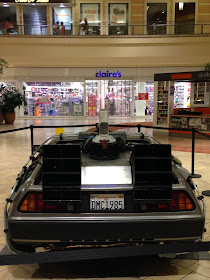 |
| (Click on image to zoom in) |
We caught a movie at the mall theater-plex over the weekend. Being there prompted the questions: what is the history of the mall and what is the meaning behind the place name "Puente Hills?"
Puente Hills Mall opened in 1974 with these statistics: stretching throughout 94 acres, it was built at a cost of $40 million in the City of Industry, anchored by four major department stores. It would be the first of three malls to be completed in the San Gabriel Valley that would be "air-conditioned and enclosed," taxing the viability of the older, open-air Eastland Shopping Center in Covina. The promises of an indoor climate in the Puente Hills Mall raised concerns as the nation was undergoing an oil embargo crisis.
Two other shopping malls to follow were Fashion Park in Arcadia, and Fashion Plaza in West Covina. These developments surely foiled the work of the Puente Hills Community Coalition that had, as late as 1972, worked to curtail home construction in places like Diamond Bar, Rowland Heights, the Workman Mill area, and La Habra Heights. Even before the Puente Hills Mall was completed, the developer, Western Harness Racing Inc., unveiled another plan to build Puente Hills East, a automotive shopping center, home furnishings center as well as offices, to be completed about 1979.
The mall gained a bit of notoriety when its south parking lot was featured in the 1985 film, "Back to the Future." (Update from October, 2015 - see end of post for a mall promotion of the movie's 30th anniversary)
The Puente Hills extend from the western face (roughly at the location of Rio Hondo College) to Rowland Heights on the east, and the Pomona Freeway providing a general northern boundary, and the mountains have the following at its base: Whittier, City of Industry, Hacienda Heights, La Habra, Rowland Heights, and Brea. The hills have provided a century of petroleum sustenance, too.
 |
| (Courtesy of the Library of Congress American Memory Map Collection.) |
The name "Puente Hills" is derived from the region that provided a "bridge" to dry land as the Spanish expedition led by Don Gaspar de Portola crossed a San Jose creek in 1769. Rancho de la Puenta encompassed nearly 49,000 acres of former mission land. The rancho was eventually granted by the Mexican government to "foreigners", the first overland American settlers, John Rowland and William Workman, about 1845. By the end of the U.S. war with Mexico, the spelling, Puenta had changed in land claim records to Puente.
Neighboring ranchos of the 1840s Mexican California included Rancho de la Luis Arinas in the north, next to Rio San Gabriel, and Rancho El Susa, also owned by Arinas, which later became Azusa when Englishman Henry Dalton bought both properties. Another neighbor was Ricardo Vejar's Rancho de San Jose. Vejar also eventually purchased Rancho Los Nogales from the widow of Jose de la Luz Linares.
October 17, 2015: While waiting for a 10:40 p.m. screening of Pan, a stroll through the mall brought an encounter with a Delorean on display, apparently to celebrate the Puente Hills Mall parking lot as one of the film locations for the original Back To The Future.
 | ||
|
|
In response to a couple of recent comments, here are photos I took way back in March of 2022. I went to Macy's and came upon their storewide closing sale. Sad to see them go even though I rarely went there in recent years...














































